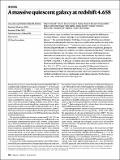Files in this item
A massive quiescent galaxy at redshift 4.658
Item metadata
| dc.contributor.author | Carnall, Adam C. | |
| dc.contributor.author | McLure, Ross J. | |
| dc.contributor.author | Dunlop, James S. | |
| dc.contributor.author | McLeod, Derek J. | |
| dc.contributor.author | Wild, Vivienne | |
| dc.contributor.author | Cullen, Fergus | |
| dc.contributor.author | Magee, Dan | |
| dc.contributor.author | Begley, Ryan | |
| dc.contributor.author | Cimatti, Andrea | |
| dc.contributor.author | Donnan, Callum T. | |
| dc.contributor.author | Hamadouche, Massissilia L. | |
| dc.contributor.author | Jewell, Sophie M. | |
| dc.contributor.author | Walker, Sam | |
| dc.date.accessioned | 2023-06-01T09:30:07Z | |
| dc.date.available | 2023-06-01T09:30:07Z | |
| dc.date.issued | 2023-07-27 | |
| dc.identifier | 286588925 | |
| dc.identifier | 1460798e-2724-4b95-a73e-06e9a15da89d | |
| dc.identifier | 85165132412 | |
| dc.identifier.citation | Carnall , A C , McLure , R J , Dunlop , J S , McLeod , D J , Wild , V , Cullen , F , Magee , D , Begley , R , Cimatti , A , Donnan , C T , Hamadouche , M L , Jewell , S M & Walker , S 2023 , ' A massive quiescent galaxy at redshift 4.658 ' , Nature , vol. 619 , no. 7971 , pp. 716–719 . https://doi.org/10.1038/s41586-023-06158-6 | en |
| dc.identifier.issn | 1476-4687 | |
| dc.identifier.other | RIS: urn:8B0FE261491519075BC03336F9D726F0 | |
| dc.identifier.other | RIS: Carnall2023 | |
| dc.identifier.uri | https://hdl.handle.net/10023/27722 | |
| dc.description | Funding: A. C. Carnall thanks the Leverhulme Trust for their support via a Leverhulme Early Career Fellowship. R. J. McLure, J. S. Dunlop, D. J. McLeod, V. Wild, R. Begley, C. T. Donnan and M. L. Hamadouche acknowledge the support of the Science and Technology Facilities Council. F. Cullen acknowledges support from a UKRI Frontier Research Guarantee Grant (grant reference EP/X021025/1). A. Cimatti acknowledges support from the grant PRIN MIUR 2017 - 20173ML3WW 001. | en |
| dc.description.abstract | The extremely rapid assembly of the earliest galaxies during the first billion years of cosmic history is a major challenge for our understanding of galaxy formation physics (1; 2; 3; 4; 5). The advent of JWST has exacerbated this issue by confirming the existence of galaxies in significant numbers as early as the first few hundred million years (6; 7; 8). Perhaps even more surprisingly, in some galaxies, this initial highly efficient star formation rapidly shuts down, or quenches, giving rise to massive quiescent galaxies as little as 1.5 billion years after the Big Bang (9; 10), however, due to their faintness and red colour, it has proven extremely challenging to learn about these extreme quiescent galaxies, or to confirm whether any exist at earlier times. Here we report the spectroscopic confirmation of a massive quiescent galaxy, GS-9209, at redshift, z = 4.658, just 1.25 billion years after the Big Bang, using JWST NIRSpec. From these data we infer a stellar mass of M∗ = 3.8 ± 0.2 × 1010 M⊙, which formed over a ≃ 200 Myr period before this galaxy quenched its star formation activity at z=6.5+0.2−0.5, when the Universe was ≃ 800 million years old. This galaxy is both a likely descendent of the highest-redshift submillimetre galaxies and quasars, and a likely progenitor for the dense, ancient cores of the most massive local galaxies. | |
| dc.format.extent | 4 | |
| dc.format.extent | 6794399 | |
| dc.language.iso | eng | |
| dc.relation.ispartof | Nature | en |
| dc.subject | QB Astronomy | en |
| dc.subject | QC Physics | en |
| dc.subject | 3rd-DAS | en |
| dc.subject | MCC | en |
| dc.subject.lcc | QB | en |
| dc.subject.lcc | QC | en |
| dc.title | A massive quiescent galaxy at redshift 4.658 | en |
| dc.type | Journal article | en |
| dc.contributor.institution | University of St Andrews. School of Physics and Astronomy | en |
| dc.identifier.doi | https://doi.org/10.1038/s41586-023-06158-6 | |
| dc.description.status | Peer reviewed | en |
| dc.identifier.url | https://arxiv.org/abs/2301.11413 | en |
This item appears in the following Collection(s)
Items in the St Andrews Research Repository are protected by copyright, with all rights reserved, unless otherwise indicated.

